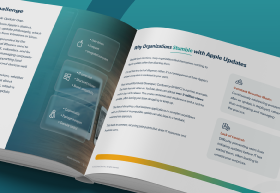The arrival of major operating system (OS) updates, particularly from Apple, brings a mix of excitement and apprehension for IT professionals. With new developments often unveiled at events like the Worldwide Developers Conference (WWDC), user anticipation runs high.
However, the reality for IT teams is that these updates can quickly become an operational headache, leading to inefficiencies, security risks, and user dissatisfaction.
The problem?
Many organizations approach Apple updates reactively. This not only strains IT resources but also leaves organizations vulnerable to security lapses and compatibility issues.
IT leaders need a proactive framework to shift from reactive to resilient. This involves analyzing updates via three critical lenses:
- The End-User Experience (The People Impact)
- The Technology Ecosystem (The Compatibility Impact)
- The Management & Security Framework (The Control Impact)
By applying these lenses, OS updates shift from disruptive events into opportunities for enhanced security, compatibility, and user satisfaction.
The Changing Scenario in OS Updates
Beyond Bug Fixes: The Impact of Apple OS Updates
Updates like macOS Sonoma and iOS 18 go far beyond fixes. They reshape workflows, redesign interfaces, and improve security. Unlike incremental patches, these updates can transform how organizations operate.
For MSPs, SMEs, and IT leaders, staying current is essential.
The latest features and system changes drive efficiency, innovation, and stronger security across the business.
The Consumerization of IT
Apple’s user-centric philosophy adds complexity for IT teams managing corporate and bring- your-own-devices (BYOD). Employees demand the same seamless update experiences they receive on personal devices, creating challenges for IT administrators who need to balance security and operational stability.
Why Reactive Management Falls Short
Reactive approaches often result in the following pitfalls:
- Constant reaction mode: IT teams addressing post-update issues instead of preparing for them.
- OS version fragmentation: Disparate OS versions lead to compatibility chaos and security gaps.
- Lack of control: Users initiating updates prematurely disrupt IT timelines.
- Security risks: Delayed updates leave vulnerabilities exposed.
Proactive preparation isn’t about controlling Apple’s release cycle but designing an impact-specific strategy to stay ahead of changes.
The 3 Lenses of Impact Analysis
1. The End-User Experience (The People Impact)
Technology serves people. Updates must prioritize productivity and user confidence.
Key considerations:
- Anticipating behavioral shifts: Will UI changes confuse employees? Are workflows impacted by feature updates?
- Communication is key: Transparent messaging fosters trust. Inform teams about testing progress, rollout timelines, and potential disruptions.
- Training and support: Major updates may require refreshes to training resources, FAQs, or helpdesk capabilities.
Build an “Apple Tiger Team,” comprising power users from different departments, to beta test updates and provide feedback. This group can identify issues early and act as adoption advocates during broader rollouts.
Goal: Foster user trust and ensure productivity remains uninterrupted during OS transitions.
2. The Technology Ecosystem (The Compatibility Impact)
Every OS rollout ripples through interconnected digital environments.
Key considerations:
- Application compatibility matrix: Test all critical apps—including third-party platforms and industry-specific software—for compliance with new OS architectures.
- Talk with vendors: Engage software providers early to align update roadmaps and avoid surprises post-deployment.
- Hardware readiness: Verify that hardware devices—from docking stations to network equipment—are compatible with the new OS.
- Integration checks: Assess workflows tied to CRM, ERP, and identity management systems to prevent disruptions.
Goal: Minimize the risk of downtime, ensuring critical business applications perform flawlessly post-update.
3. The Management & Security Framework (The Control Impact)
Maintain IT oversight, enforce policies, and secure your Apple fleet with robust management.
Key considerations:
- Mobile device management (MDM): Leverage MDM as the “command center” for deferred updates, gradual rollouts, and managing unauthorized installations.
- Security posture: Analyze whether the update patches vulnerabilities or introduces new ones. Keep track of critical security advisories like the FORCEDENTRY exploit, which highlights the importance of timely security patching.
- Compliance and audit readiness: Ensure update frameworks align with industry compliance standards such as HIPAA or PCI-DSS, and use reporting tools to document device-level compliance for audits.
- Automation and monitoring: Automate version tracking, flagging non-compliant devices while monitoring for anomalies like unauthorized updates.
Goal: Establish IT control, maintain compliance, and fortify security in the face of evolving update requirements.
Beyond Reactionary IT Management: Next Steps
The challenges posed by major OS updates are deeply intertwined with an organization’s preparation strategy. By using the three lenses of impact analysis, IT leaders shift from reactive problem-solving to proactive resilience.
Take the next step: To develop a proactive Apple OS update strategy tailored to your organization, download our free eBook, Mastering Apple Updates: A Strategic IT Guide. This comprehensive resource provides actionable frameworks to build resilience across people, technology, and security.
With thoughtful planning and the right tools, Apple’s OS updates become less of a disruption and more of a strategic opportunity. Don’t wait for the next release to scramble. Transform your IT strategy now.





